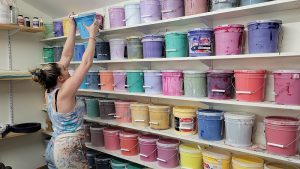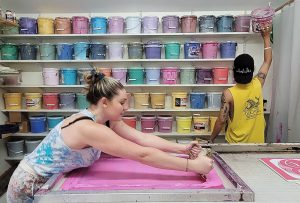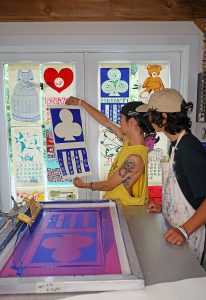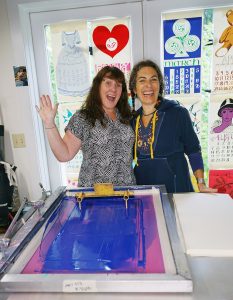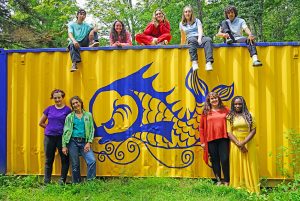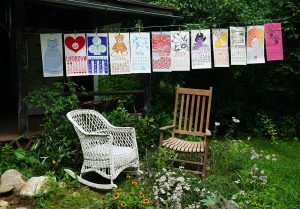LILY HUGHES’ GRANDFATHER John ffrench was born and raised in Ireland in a town called Ballinasloe in Co. Galway. Her American grandmother Primm met John in Italy where they were both going to art school. Soon she was living in Arklow, Ireland, where they began their family. In 1969, they migrated to Stockbridge, Massachusetts. A year later they launched the Dolphin Studio.
The Dolphin Studio is a family-run, hand screen printing company based in the Berkshire Hills of Western Massachusetts. They produce a hand-printed, 12 by 24-inch, 12-page calendar annually, featuring artwork designed by three generations of family members, and package it in a hand-printed envelope. They also offer printed kitchen towels, clothing items, posters, art prints, journals, and custom items like wedding invitations, posters, and announcements.
Lily is 22. She started printing when she was little, next to her grandfather, and began working in the shop at 14. She has been overseeing printing and production the last three years. The handful of employees at The Dolphin Studio make up a close-knit print team. “I love going to work. It’s like hanging out with friends, doing art all day,” she says. Many of the staff are also her family members. Lily’s grandparents have since passed, so the shop is currently run by her aunt Crispina ffrench (who she calls the OG) and mother Sofia Hughes. The rest of the print shop is a mix of family and friends with ages ranging from 14 to 34.
The shop was originally formed in John and Primm’s home. Now the family and their hires all print in one house set up as a studio. “It’s definitely hard sometimes and frustrating to not talk about work at dinner,” says Lily. “My mom has to be in the middle.”
The Dolphin Studio prints mainly in the summer months, taking off from January to March, with most orders coming in – or as Lily likes to say, “a constant ringing” – October through December. “We have regulars who have been purchasing the calendar for 45 to 50 years [they have an 88 percent return rate],” she says. “They call our house number.” Sofia handles all orders, and each person in the family, including Lily’s sister, cousins, and aunts, designs a month for the annual calendar. It’s important that even when family members can no longer physically contribute, they still have their month. During the last three years of John’s life, he made designs for future calendars. “He was very particular about his calendar design,” says Lily. Or they pull from a portfolio of vintage designs made by John, Primm, or Lily’s aunt Felicitas who has multiple sclerosis.
Lily picks the colors, makes 10 different variations, and her family will pick the ones they want for their month. Kerry Willig, printer, screen maker, and the oldest of the bunch (34), shoots the screens. Just four printers are printing at one time, and they print on average 1000 pieces a day. “We printed 1200 in six hours once because of Johnny,” Lily says about John (Johnny) Ringer Jr. (22). “He’s the fastest printer I’ve ever seen.” His brother Mickey (16) helps and is joined by Lily’s cousin Lucy (15), and two artists in the family, Jamie and Violet (both 14).
The number of calendar orders has grown each year, but double growth occurred when they were featured in Martha Stewart Living magazine’s December 2017 issue. “We weren’t really prepared,” says Lily. “The Studio typically prints 1000 to 2000 calendars annually. This year, their first run was 3000, and they hope to complete 4000 total. “It will be easier because all the screens are made and the ink is mixed and we have all the paper,” she says.
If you’re looking for an automatic somewhere in the shop, you won’t find it. “We hand screen everything,” says Lily. “No machines.” They also use racks her grandfather used until his death in 2010. “We’re printing on one professional print table, a vacuum, that is 50 years old.”
When asked what the benefits to manual screen printing are, Lily says, “It is the way we have always done it. It is easy to teach and learn. Screen printing by hand is becoming less popular so we think it’s important to continue with the tradition. I don’t want to say we never will [purchase automatic machines], but it isn’t something that we are planning to do anytime soon.”
As for Lily, she’s not sure screen printing is her future. “I love silk screening, but I never define myself as an artist,” she says. Lily is currently going to school for communications and graphic design at Westfield State University in Massachusetts. She took a gap year and worked as a chocolate maker in Alaska, and is now interested in producing podcasts.
PHOTO GALLERY (22 IMAGES)


 Case Studies2 months ago
Case Studies2 months ago
 Art, Ad, or Alchemy2 months ago
Art, Ad, or Alchemy2 months ago
 Andy MacDougall2 months ago
Andy MacDougall2 months ago
 Columns4 weeks ago
Columns4 weeks ago
 Editor's Note3 weeks ago
Editor's Note3 weeks ago
 Marshall Atkinson3 weeks ago
Marshall Atkinson3 weeks ago
 Case Studies4 weeks ago
Case Studies4 weeks ago
 News & Trends2 months ago
News & Trends2 months ago









